History of graphic adventure

Space Quest . Day of the Tentacle . Gabriel Knight . Monkey Island . For players of a certain age, the mere mention of these names evokes memories of the whole world of games, now almost lost.
On the modern market, graphic adventure games struggle for a place in the sun, but once they were at the top of bestseller lists year after year. The genre took off at the peak of computer gaming in the second half of the 1980s, and experienced an equally sharp drop a decade later. He defined the sad fate of the largest companies in the games industry, even though the primitive game graphics became the backdrop of millions of childhood memories. Adventures gave us Roger Wilco, Sam and Max, as well as the whole world of Myst . But today, only a few gamers know the history of the genre entirely, or how the classic Sierra and LucasArts games of the late 1980s and early 1990s disappeared under the onslaught of first-person shooters.
I'll tell you how we got from King's Quest to The Longest Journey and why this is important. To get to the end of this story, you do not need to use a text parser, combine two mysterious items from your inventory to solve a crazy puzzle, or do pixel-hunting on the entire screen.
A picture is worth a thousand words
It is not surprising that the origins of the graphic adventure lie in the text adventure. Inspired by the version of Will Crowther's Adventure , accidentally discovered during a remote writing session on the mainframe, a team of husband and wife - Ken and Roberta Williams - created the Mystery House game for Apple II in 1980. Mystery House was terribly simple text adventure, which had one important feature: monochrome linear drawings accompanying the text. Soon came the second game, Wizard and the Princess , in which color graphics appeared.

Wizard and the Princess is the first adventure game with color graphics support.
These simple illustrations were enough to breathe life into the games — despite the primitiveness of the text parser, you could get lost in the game world, and many succeeded. Games were sold wherever they were available. The couple was so inspired by the success of two games that they decided to change the profile of their company On-Line Systems from consulting to game development. This is how the graphic adventure was born, as well as one of the most important developers of this genre.
However, the first impetus to the development of the genre occurred in 1983. The new company, now renamed Sierra On-Line, contacted IBM and offered $ 700,000 for creating a game capable of demonstrating the multimedia capabilities of the planned PCjr model. And so the game was born. laying the foundations of the genre - King's Quest: Quest for the Crown, along with the scripting language Adventure Game Interpreter (AGI), which became the foundation for the Sierra adventure game before crowding out the new technology in 1988.
PCjr failed, but King's Quest stormed the world of computer games by storm: it was ported and redone on several other platforms. The game instantly received bestseller status. It was the first computer game supporting the 16-color EGA standard, as well as the first pseudo-three-dimensional world in which players controlled the character in a third-person perspective. Characters could move in front of, behind or above other objects on the screen. Called some "interactive cartoon", King's Quest seemed to breathe life into adventure games and fairy tales that inspired it.

The first King's Quest may have looked sweet and innocent, but already the first screen in it was in danger.
However, King's Quest was not perfect, and sometimes suffered from a curve of logic and a weak text parser. In some respects, the game was more complicated than its text relatives, because it lost the details that were clearly visible on the screen when responding to the “look” command. The problem of the selection of the correct verb, the long-standing headache of all adventure games, text and graphic, now adds the problem of the selection of the correct noun (for example, when the object is called “rock” and when “stone”?). There were problems in navigation. The illusion of three-dimensional space, projected onto a two-dimensional surface, was precisely an illusion - the main character Graham had to beg for stairs, a bridge or a cliff in a non-intuitive and dangerous way in this game with many deaths.
A mouse appears on the scene.
Sierra was not the only company to make progress in the genre that was born. In January 1984, the revolutionary Apple Macintosh computer was released. The standard package included a high-resolution display, a graphical user interface and a mouse. He became the signal for a paradigm shift in computers, and a handful of smart developers saw an opportunity to expand the capabilities of the Mac with games. Silicon Beach Software released in 1984 the first point-and-click adventure game Enchanted Scepters with drop-down menus for selecting player actions and text descriptions in a separate window from static graphics. However, ICOM Simulations has become a real innovator, having released the detective game Déjà Vu next year.
This first MacVenture game provided an interface with full point-and-click support. In separate windows they showed (mostly static) visual scenes, possible exits, comments from the second person and a multi-level inventory system in which some objects could be stored inside others. The player could drag objects around the stage and into his inventory. Other actions usually included a mouse click on one of eight options: - Examine (explore), Open (open), Close (close), Speak (talk), Operate (impact), Go (go), Hit (hit), Consume (use) - when you click on the item in the scene or in the inventory. Often a double click could perform an operation of exploring or opening an object (depending on which action seemed more appropriate in context).

Early point-and-click adventure for Macintosh Déjà Vu
To a large extent, thanks to its energetic plot and sharp humor, Déjà Vu instantly became a classic. Soon, it was ported to several platforms, of which it received the greatest success on the NES. On this console, the interface has been greatly simplified to cope with low resolution and control from the controller. Déjà Vu was followed by other MacVenture games, including Shadowgate and Uninvited , but none of them matched the popularity or prestige of the Quest Sierra games. Before becoming a standard in the genre, the concept point-and-click without typing text had to wait a little longer.
In the meantime, Sierra moved on. The first game was followed by two sequels King's Quest , as well as the first game in the new Quest series - Space Quest , which added to the Sierra repertoire the comedy cosmoopers genre.
Lost in space
The player’s goal in Space Quest: The Sarien Encounter was to return the stolen Star-Generator technology, but the game itself was hardly serious science fiction. The main character of the game was a hapless janitor who woke up from sleep in the closet and discovered that the entire crew of the ship was killed by alien aliens. Unlike previous Sierra adventure games, the game had a lighter approach, all sorts of deaths were accompanied by jokes, mostly concerning the player, and frequent references in the plot made it clear that the player not only embodied the character on the screen, but also played the game. Great fun could be obtained by exploring new ways of death, including the memorable transfer of the main character Roger Wilco to Daventri, the world from King's Quest . The game had many references to pop culture, including the Blues brothers and ZZ Top in the form of aliens, which appeared in the bar Ulence Flats.

Space Quest , Sierra's favorite first foray into science fiction territory, quietly ridicules the player for excessive meticulousness.
In 1987, Space Quest 's sequel, Vohaul's Revenge , was warmly received. It continued the story of the main character of the series, Roger Wilco, and introduced me to the Sierra adventure line. Not having had time to heroically deal with the sariens, Roger got a promotion to the main janitor - a meaningless post, because he was the only janitor. As a child I stumbled upon this game a few years after graduation and was immediately struck by its detailed world, oozing humor from each hole. In the game, you can stick to a tree (trying to climb on it) or cause digestive problems in the monster that devoured you with huge tentacle-shaped roots. Gravity, not your worst enemy, Sludge Vohaul, was the greatest challenge mercilessly pulling you to the ground again and again.
The suit makes a man
In the same year two more iconic favorites came out. The Police Quest was attended by the plot and gameplay, clearly following this police protocol, with the famous dry and black Sierra humor, creating a comic effect. But a much more important event was the game Leisure Suit Larry in the Land of the Lounge Lizards . In 1986, company founder Ken Williams asked programmer Al Lowe to create for AGI a version of the old text adventure Softporn . Lowe kept the Softporn puzzles, but added a 38-year-old Larry Laffer to the game. Thus a legend was born - clumsy and pitiful attempts to have sex with every woman encountered led to dozens of incredible and funny situations, as well as to comedy-cruel deaths.
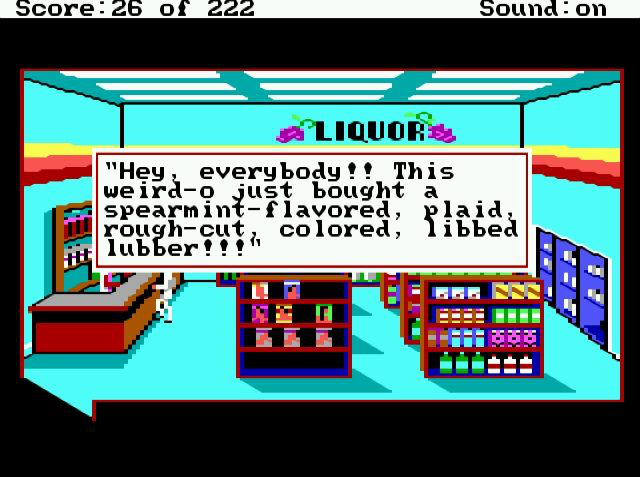
The infamous Leisure Suit Larry in the Land of the Lounge Lizards
For young players like me, the quiz on age checks that had to be passed after launching Larry was a game in itself. If you tell the game that you are older than a certain age, then it will not let you go right away, if you say that you are over 18 years old, the game will offer to prove your age by answering a series of quiz questions related to politics and pop culture. These questions turned successful attempts to get to the game into something like an achievement - you earned the right to play. When you managed to get inside, you fell into a game full of mocking depravity. It was one of those Sierra games in which a text parser was used - the narrator had a witty answer to a solid number of ridiculous or indecent commands (including expletives).
Larry sold poorly - only 4,000 copies of the game "went away" in the first month. But the rumors spread quickly, and in July 1988, it became the third in the list of best-selling computer games in the United States, just one year after the release. In addition, around the world, people played millions of pirated copies. In one interview for RetroGamer, Lowe recalled the words of a Russian computer consultant - Larry was so widely distributed in Russia that it seemed like an integral part of DOS.
No deaths
Lucasfilm Games (in 1990, which became LucasArts) entered the market of graphic adventure games in 1986, releasing Labyrinth: The Computer Game for almost all then popular home computers. The authors of Labyrinth drew inspiration from the Jim Henson film of the same name. The game used the text interface of the slot machine instead of the usual text parser. Players chose a verb from the left slot and a noun from the right slot to choose an action. However, the second attempt of the company in the genre of adventure has really “taken off”.
A Lucasfilm programmer named Ron Gilbert loved King's Quest , but he didn’t like the annoying text parser and the player’s frequent deaths. He created Script Creation Utility for Maniac Mansion (SCUMM, a scripting utility for Maniac Mansion), which was used in the company's second graphical adventure game, Maniac Mansion . SCUMM borrowed many of the best sides of the AGI Sierra engine and MacVenture ICOM interface - all verbs and inventory were located at the bottom of the screen, and the scene was animated by moving characters.

Maniac Mansion , the first game with SCUMM
In Maniac Mansion there were several characters between which the player could switch, there were several endings in it, and the puzzles were generously laced with humor. Thanks to the graphics of Gary Vinnyk and the entourage inspired by the horror films of category B, the game had its own look and style, largely supported by the rejection of any seriousness. Although, unlike later games under SCUMM, death in Maniac Mansion is possible, it requires a big mistake from the player when controlling each of the three characters.
Ron Gilbert sought to implement a more player-friendly philosophy, so players were not punished for curiosity and they did not need to return to the early stages of the game, when it was obvious that they lacked important items (and this was the norm in previous adventure games). Such an emphasis on convenience soon embraced the entire genre, opening it to new audiences. However, the greatest legacy of Maniac Mansion was still the SCUMM engine, which over the next decade was used to create thirteen more games.
Maniac Mansion was followed by Zak McKracken and the Alien Mindbenders in 1988, Indiana Jones and the Last Crusade (1989) and Loom (1990), followed by Tim Schafer and Dave Grossman teamed up with Ron Gilbert to create a pirated pirate Adventures of The Secret of Monkey Island . LucasArts continued to master its player-friendly comedic approach to adventure games, the game was the first to introduce a new hero - Guybrush Tripvud who dreams of becoming a pirate. The game was attended by dozens of jokes "for their own" and ridicule over adventure paths, as well as the favorite by many mini-game "Battle with swords with insults," in which the real battle with swords is replaced with a series of insults and witty answers.

Three-headed monkey has become a frequent joke in the games of the series Monkey Island
Despite the fact that Monkey Island came to life thanks to SCUMM, which promised players simplicity, it featured the most elaborate puzzles in the world, including the use of wheel-equipped rubber chicken and smoked herring. The eccentricity of the puzzles along with the bizarre characters became part of the charm of the game, and its internal logic was based on foolishness and clever play on words.
Level up
In 1988, Sierra replaced the AGI scripting language with SCI (Sierra's Creative Interpreter), and again King's Quest was used to demonstrate the latest technology. King's Quest IV: The Perils of Rosella is also notable for being one of the first PC games with sound card support (AdLib Music Card and Roland MT-32), as well as the release in AGI and SCI versions (AGI for older systems, SCI for everyone else).

King's Quest IV: The Peril's of Rosella has become an important upgrade for the visual part of Sierra adventure
The most important innovations of SCI were not the interface with icons and mouse control as an alternative to the text parser of old games, but the improvement of graphics and sound, plus the transition to an object-oriented language, which allowed the game to work the same on all platforms long before Java. Gamers and critics were shocked by the possibilities of the new engine, which came closest to the ideal of cinematic quality. Old games were reworked and re-released with high-resolution graphics and a new point-and-click interface, and new games such as Police Quest II , Space Quest III , and Hero's Quest: an adventure hybrid and RPG to the maximum used the powerful features of the new engine.

The main character of Police Quest II Sonny Bonds got a hard lesson that you should always wear headphones at a shooting range.
Police Quest II: The Vengeance continued the story of the original Police Quest , and the main character, Sonny Bonds, was transferred from patrol officers to homicide detectives. By that time, people were used to spending time in Quest games looking for fun ways to die or probing for the capabilities of the text parser. Police Quest games strictly adhered to the police protocol: if you do not follow the procedures, you will die. I spent hours searching for the most interesting ways to violate the charter: pulling out weapons in public, shouting at a suspect, uncovering my true identity while under cover, trying to bribe or put pressure on colleagues - that's just a fraction of what I tried to do (just to see what will happen). But if you take the game seriously, the Police Quest could become a useful window into the police life and an opportunity to feel the complexity of catching criminals without breaking the law.
Sierra continued to refine the SCI engine throughout its life cycle. As always, the most serious updates were shown in King's Quest games. In King's Quest V (1990), the first major update appeared, SCI1, which added the aforementioned interface with icons and the transition to a 256-color VGA-graphic (in the 1992 version, the full acting voice was also added to the CD-ROM). Space Quest IV: Roger Wilco and the Time Rippers may have become the most impressive demonstration of the technology, but at the same time it contained beautiful hand-drawn graphics and a funny plot full of references to itself — Roger Wilco fell into many fictional sequels (as well as the original Space Quest ).

Beautifully painted and as always wacky Space Quest IV
In 1991, LucasArts developed a new SCUMM audio component - iMUSE (Interactive Music Streaming Engine). Composers Michael Land and Peter were responsible for the creation of the engine. He overcame many of the limitations of MIDI technology. Sharp gluing and abrupt musical transitions are a thing of the past, now dynamic sound has appeared in the SCUMM adventure games. This immediately gave the company a competitive advantage - none of the competitors had such a technology that allowed them to create much more interesting and subtle audio tips in games. New technology was first used in Monkey Island 2: LeChuck's Revenge , which was the last game created by SCUMM creator Ron Gilbert at LucasArts (Gilbert left to set up Humongous Entertainment with his colleague Shelly Dey).

Monkey Island 2 carried old and new jokes, improved graphics and a new audio engine compared to its predecessor: iMUSE
In addition, the addition of iMUSE immediately became noticeable. Monkey Island 2 felt more complete and connected than all previous LucasArts games. It seemed that the music instantly reacted to the actions of the player, no matter how unpredictable they were. This gave the feeling that the whole system is much more complex and extensive than it actually was.
About hyperactive rabbits
Perhaps the most memorable characters from all adventure games were the foul-mouthed police officers Sam and Max, who debuted at Sam & Max Hit the Road for the first time in 1993. The game became significant not only because it started one of the most beloved adventure franchise players: it made visible changes to the SCUMM engine and turned out to be the first adventure game LucasArts after leaving the company of legendary designer Dave Grossman. Day of the Tentacle , released earlier that year, made changes to the backgrounds, providing more detailed graphics. In addition to the updated Sam & Max engine, a redesigned user interface was added - the list of verbs was replaced with several cursor modes, and the inventory was moved to the menu hidden from the screen.

Sam & Max was not afraid to laugh ... nothing
Sam’s original, but harsh, notes and Max’s sarcastic wit with excellent voice acting were perfect for the contemporary entourage, because the game barely perceptible or openly made fun of American realities. In their travels, Sam and Max find tourist attractions - a huge tangle of twine and a small rock, unsuccessfully trying to resemble a frog, a country music star, leading an absurdly extravagant egoist (complete with two huge statues and an elevator bed).
There were only icons in the dialog selection menu, so the jokes could not be read in advance, which created in the script, probably the weirdest absurdity of phrases in the entire history of video games. Take, for example, the case when Sam says anthropomorphic dog (quite spontaneously): “My mind is a whirlwind of miasms of brilliant thoughts and high-spirited ideas.”
Sam & Max ’s simplified interface was a big step forward for graphic adventure games with characters, especially for those created by LucasArts - it allowed a large part of the environment to fit on the screen and made the interaction more intuitive. But other companies - including Sierra with its SCI - were ahead of LucasArts. Dynamix released Rise of the Dragon in 1990, followed in 1991 by Heart of China and The Adventures of Willy Beamish . In these games, there were minimal interface elements and a context-sensitive cursor, which automatically changed the mode depending on the position on the screen.
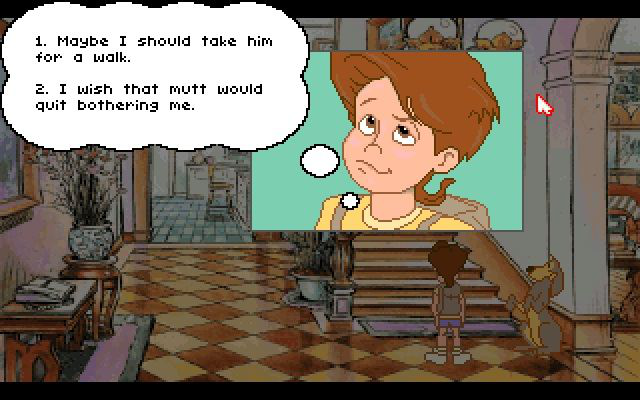
The Adventures of Willy Beamish is one of several Dynamix-designed adventure games. In 1990, the company was bought by Sierra.
Literary inspiration
In 1993, Sierra released the game, widely recognized as one of the best in the story. Gabriel Knight: Sins of the Fathers used a more literary approach than her predecessors, and she had a deep story about a distressed writer and the mystery of the present murder. The gameplay of the game resembled its contemporaries, but it looked more like a revived graphic novel - like the original King's Quest, it gave the impression of an interactive cartoon. The 1994 cyberpunks hit, Beneath a Steel Sky, also expanded the genre’s plot potential through an exciting story in the entourage of Australia’s dystopian future.
The plot of the mysterious story by Gabriel Knight has evolved more slowly than in other graphic adventure games, but its pace never seemed too long, and its “maturity” rejected the widespread argument that the games are interesting only to children. The game used a new interface, unlike anything created by Sierra earlier: some actions, for example, “use / execute”, “speak” were broken into several slightly different actions - a strange move in the era of simplified interfaces. Players perceived the new interface in different ways. On the one hand, he added more nuances to possible actions of the player (for example, it was possible to chat or interrogate a person), on the other hand, he created unnecessary redundancy.
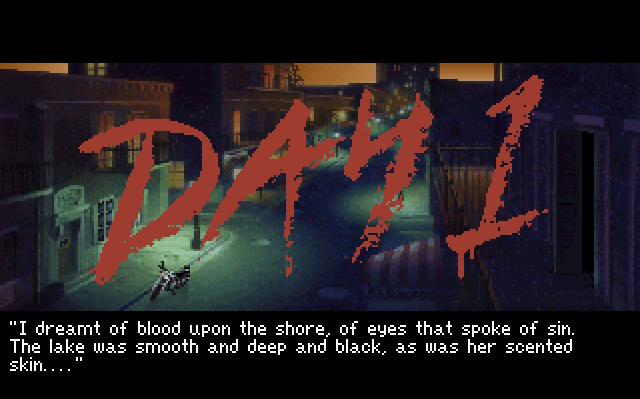
Gabriel Knight Home Screen
Danger lurking in Myst
Cyan was already well known in the Mac games market when it began work on an ambitious new game that was supposed to take advantage of the recent CD-ROM format. Using the HyperCard Apple development tool, The Manhole , Cosmic Osmo and Spelunx have been successful as research adventure games for younger audiences. Now the Millers who created the Cyan core were ready to handle a larger project. Epic and Surreal Myst was released for Mac in 1993, it had seemingly photorealistic 3D graphics and a minimal point-and-click interface.
Mystthrew players on a deserted island full of strange inventions, without the slightest knowledge, except those gathered from the game world. The game was celebrated for a complex plot and an atmospheric world, she successfully managed to integrate QuickTime video into the gameplay. Myst captured the imagination of the players and immersed them in a very detailed, but frighteningly empty world. An unprecedented mixture of realistic and fictional design of the world made the game a huge step forward, thanks to which many did not notice the poor development of characters, limited interactivity and stupid puzzle design.

We called this “photorealism”.
A port for Windows soon followed, and Myst quickly became a role model in the gaming industry. She was on the top of the sales lists and quickly became the best-selling computer game of all time (and remained so until the release of The Sims ). Together with The 7th Guest, she stimulated the widespread use of CD-ROMs - the time when 14 disks had to be constantly changed in the drive was gone.
Unfortunately, the huge success of Mystbrought the genre of adventure more harm than good. Games from the bottom lines of sales lists fell out of the market, the weaker pulled the strong along with them, the territory of the adventure flooded dozens of terrible unplayable clones, which differed little from each other. They destroyed customer attachment and killed innovation — developers sought to copy graphics and puzzles. Cyan's own Myst follower - the game Riven , released in 1997, masterfully refined the formula, creating a much improved gameplay. But she, too, spawned a wave of clones trying to earn a quick dollar.
Lighthouses of hope
Not all adventure games after Myst were bad. The Journeyman Project trilogy , which actually began even before the release of Myst , quickly became a serious competitor to the Myst franchise . At the other end of the world, in Japan, where Déjà Vu has had a greater impact than in the West, the game Snatcher in the style of Blade Runner author's Metal Gear Solid Hideo Kojima finally found an English version in 1994 (for the Sega CD). In 1995, the Discworld series of games based on the fantasy author Terry Pratchett was born . Voice acting in it involved the famous comedian Eric Idle.
I Have No Mouth and I Must Scream(“I don’t have a mouth, but I have to shout”), as the fantastic title hints, in an adaptation of a short story with the same name, it explored a twisted horror theme. In the game with one of the most original adventure concepts of Bad Mojo, the player in the image of a cockroach man had to save the life of his terrible, but sympathetic landlord and find a way to become human again. From the cockroach's point of view, the dirty apartment building received a new scale - you could explore the floors, walls and furniture from the first and third person in order to find a means of salvation from your unpleasant bodily transformation.
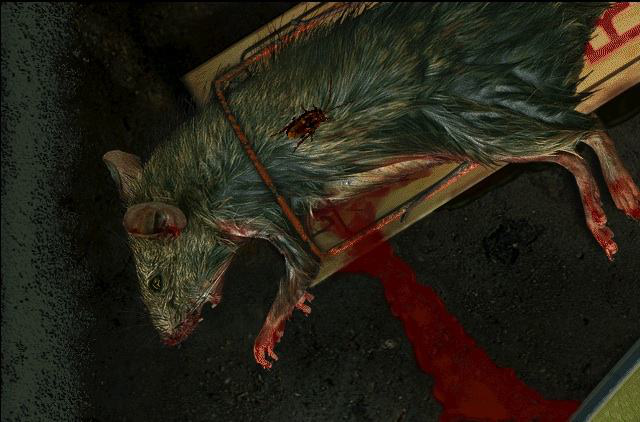
Yes, we control the cockroach, and no, the rat is not dead.
The British company Revolution Software made a good impression thanks to the release in the early 90s of Lure of the Temptress and the popular Beneath a Steel Sky . On the eve of a sharp collapse of the genre, she managed to repeat her previous success thanks to the clever Broken Sword: Shadow of the Templars (originally in the USA it was called Circle of Blood ) and its sequel The Smoking Mirror . Both games met with loud recognition.
In the first broken swordtells the story of an American tourist in Paris, George Stobbart, who barely survives a bomb explosion in a cafe and notices a suspicious clown (aren't they all like that?) escaping from a crime scene. Unsatisfied with the investigation of the crime by the local police, he decides to start his own. The result was a leisurely, but delightful (and often humorous) story about intrigues, affecting conspiracy theories and myths about Knights Templar, with graphics that are beautiful even by modern standards.

Relaxed but impressive Broken Sword
Controversial development of the genre
Sierra met with misunderstanding by replacing fourth police officer Quest with former California patrol officer Jim Walls with former Los Angeles Police Department chief Daryl F. Gates, and then, in 1995, releasing non-adorned Police Quest and “interactive movie” with horror themed Phantasmagoria . Due to excessive violence and other adult content, the high-budget Phantasmagoria was met with conflicting reviews. The game was banned in Australia, and as many as seven CDs were required to store live video. But she still managed to be one of the best selling games of the year.

FMV games have been a terrible trend. Despite its success, Phantasmagoria was no exception.
Looking back at Phantasmagoria , one can only wonder at its good sales. Fake and cheap graphics, horrific shots are outdated as fast as clumsy interface and poor interactivity, which have a disgustingly low resolution compared to motion capture. Other FMV-based graphic adventure games were released with less pronounced contrast between the actors and their surroundings, the graphics and gameplay, but The X-Files Game (1998), Black Dahlia (1998) and The Beast Within: A Gabriel Knight Mystery (1995) failed dispel the critical mood inspired by earlier FMV games.
Express train to nowhere
Jordan Mekner, the creator of the hits of the late 80s Karateka and Prince of Persia , in the 90s was engaged in the development of the game adventure. The Last Express was a revolutionary game, which took place on a train traveling across Europe (Orient Express) on the eve of the First World War. The player becomes a refugee who assigned the documents of another passenger, whom he found dead in a compartment, jumping onto a train from a speeding motorcycle. The game was carefully recreated this "Orient Express", there was a branching of the plot, a new time rewinding mechanics, a unique visual style "modern" and rotoscoped animations. However, the revolutionary The Last Expressmade an interactive engine and a dense, focused environment. The action took place in an accelerated real time, other characters acted independently of the player and followed their own goals - the world did not wait for you and continued to live, whether you were watching him or not.
Although the game was important every second when I played The Last Express , I forgot about the time. For the first time playing a video game, I felt that I was insideof the world. I had to rush from one end of the train to the other, desperately trying to find out what the others are saying. I did not want to miss a single moment of the plot of the characters - each had its own, but the player simply could not be in two places at the same time. I could not hope to overhear the gossip of secret lesbians and at the same time reveal the story that happened between childhood friends (and now strangers to each other) Alexey and Tatyana. I didn’t want to leave the room after the Austrian violinist’s solo. I was shocked at how other passengers responded to me in the corridors or the dining car, remembering my previous behavior and actions.

The Last Express is one of the greatest adventure games in the world, but few played it
. Unfortunately, the release time was as good as it could be. The marketing department of the publisher of the game Brøderbund with its full complement left the company right before the release of the game on the store shelves. Despite four years of development and astronomical, then $ 5 million spent on development, The Last Express went on sale without marketing. As you might guess, she failed to succeed, despite the praise, including from the editors of Newsweek and USA Today that actually played her. In less than a year, it stopped selling altogether after the problems that Brøderbund encountered. (Fortunately, the game can now be played on modern systems.)
This event has become a symbol of the decline of the adventure genre. Development costs were rising, while sales (at least in North America) were falling, and marketing departments unsuccessfully tried to draw attention to a large audience to adventure games. The Last Express implemented the most innovative mechanics and ideas in video games, but they drowned in the sometimes uncomfortable interface and a few horrible, unreleased scenes. The genre needed to move forward, but it seemed that one leg was hopelessly stuck in the past, firmly adhering to outdated principles and annoying counterintuitive puzzles.
End of an era
In 1996, Sierra was acquired by CUC International. Ken Williams lost control of her company for the first time in the company's history, and Sierra’s heart and soul were methodically torn apart by corporate greed. A stage of heavy and quick layoffs followed, a creative approach suffered from this, and the new leadership demanded maximum productivity. CUC was later involved in a sensational reporting scandal that led to a drop in company shares and prison sentences for top management. In 1998, the Sierra was sold to Vivendi. The sale was immediately followed by several months of layoffs and department closures.
During all this chaos, Sierra attempted to bring its long-lived King's Quest series into the modern era, with a fully three-dimensional engine. Released in December 1998King's Quest: Mask of Eternity has failed both commercially and in reviews from critics. Released next year, Gabriel Knight 3 , showed itself a little better, even despite more encouraging reviews. Without a doubt, backstage drama influenced the quality and charm of the Sierra adventure games.

King's Quest: Mask of Eternity tried to modernize the series with a long history by switching to polygonal 3D graphics. But she failed.
On February 22, 1999, the company's studios in Oakhurst were closed, and more than 250 people lost their jobs. Sierra continued to work until the closure of Bellevue offices in 2004, but became useless long before that. The company, which became the founder of the adventure genre, was dead, only the name remained of it.
The rapid growth of first-person shooters also did not help the weakening adventure genre, which was no longer on the cutting edge of gaming technology and could not hope to compete with its new rival in terms of immersion and player rewards. Many looked towards third-person action and adventure hybrids, such asTomb Raider , Resident Evil and Metal Gear Solid . Adventurers could not compete, at least in the eyes of the gaming community. And even the most important work of Tim Schafer could not hold back the tidal wave.
Grim Fandango abandoned the obsolete SCUMM engine in favor of a new 3D engine called GrimE, which rendered characters and objects in 3D on top of pre-rendered backgrounds. The plot of the game in the world of Mexican folklore unfolded in the style of the film "Noir", which by some coincidence also formed the core of the game of the next year Discworld Noir. Driving Manuel "Manny" Calavera, a travel agent in the Land of the Dead, the player went on a journey to save an innocent client and uncover a corrupt network. Grim Fandango has a lot of praise for its amazing history, artistic style and sound, but in North America, the game sold only 100 thousand copies.

What happens if you cross Mexican folklore with films of the noir genre? Tim Schafer's masterpiece!
LucasArts released another graphic adventure game, Escape from Monkey Island (2000), before canceling the development of Sam & Max and Full Throttle sequels. Tim Schafer left the company in January 2000 and founded Double Fine Productions, which is probably best known for the Psychonauts and Brütal Legend adventure hybrids. Two companies, whose names were synonymous with the genre of graphic adventure, left it under market pressure and growing development costs.
Experts, critics and desperate fans called the adventure game dead. The genre has gone from dominating the computer games market to dying. But there was still life in it.
The story on the other side of the Atlantic
While the genre was bleeding out in the United States, adventure games continued to flourish across the Atlantic. In the first half of the decade, Adventure Soft's Simon the Sorcerer game gave the British flavor comedy LucasArts formula, and it turned out to be a great success. In 1997, the developers added The Feeble Files - a sci-fi comedy in the traditional point-and-click style. In it, the player ruled a sickly alien named Fible, who accidentally became a member of a conspiracy to overthrow a cruel ruler.

The Feeble Files had a fantastic concept and great humor, but the design was generally less impressive.
With the release of The Longest Journey in 2000, Funcom confirmed that the genre conforms to modern video game plot standards, creating one of the best scenes at the time in the industry. The main character, April Ryan, demonstrated strength and maturity rare for women in games, used her mind and cunning to fight enemies when traveling between parallel worlds, rather than appearance and sexuality.
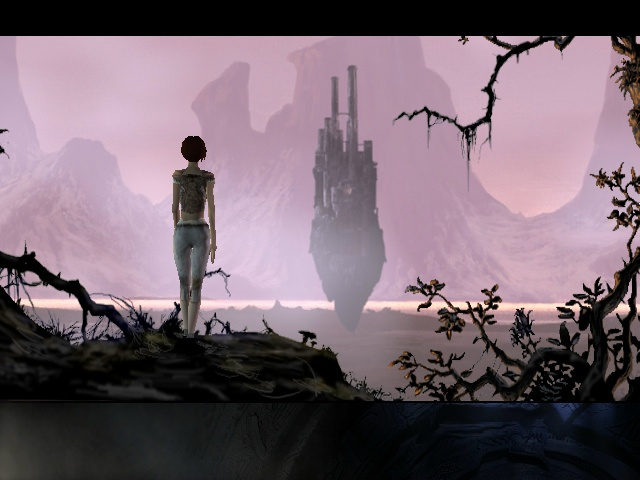
The Longest Journey tells the traditional story of growing up in a large-scale entourage that extends into two different but interconnected worlds.
The structure of The Longest Journey was more like a traditional narrative than a typical adventure game. Some plot twists resembled a fairy tale about the main character growing up. April’s realistic features matched perfectly with her mission to save the world. The game suffered only from standard problems encountered in almost every adventure game — an inconvenient inventory system, insufficient player involvement in the process, and many meaningless puzzles.
The French developer Microïds continued the theme of a strong and intelligent woman with the release in 2002 of Syberia , a stunningly beautiful game that combined in its plot and entourage the style of “modern” with the steampunk. Thanks to ingenious mechanical puzzles, well-written characters and dialogues, attention to the smallest details, the project became an outstanding release deserving more attention than it received. But he proved himself well enough to earn a sequel, which appeared in 2004 and was generally well received.
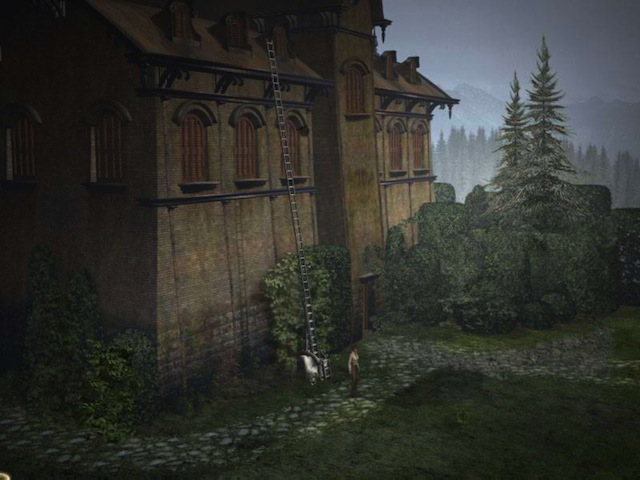
Microïds Syberia shocked critics and players with detailed graphics
Many adventure games developed in America were barely noticed in the US, but sold well in Europe, including the real-time 3D game Blade Runner with point-and-click control and the DreamForge Sanitarium psychological thriller. This difference lasted until the next decade, when the Spanish developer Péndulo Studios released in 2001 the sometimes extremely funny Runaway: A Road Adventure . The game was sold in Europe in huge quantities, but it had to travel to release in the USA for two years.
The heyday of episodic games
The European market continued to keep the adventure genre afloat until 2006, when, after acquiring rights at the end of 2005, Telltale Games founded the series of episodic games Sam & Max . Telltale exactly repeated what Ron Gilbert did when creating SCUMM: she replaced the most uncomfortable, non-intuitive element of adventure - in her case, these were puzzles - with their counterpart, which would not make players tear their hair out of irritation. The tortuous logic of the adventure games of the 90s and early 2000s is a thing of the past.
Telltale's Sam & Max also added updated interface and inventory systems with contextual options / actions - no more fruitless clicks to check if the two items are combined - if the item relates to a puzzle, just click on it once. This change did not affect the humor or eccentricity, but the games were a little lost in charm, although the main reason was the transition to 3D graphics.
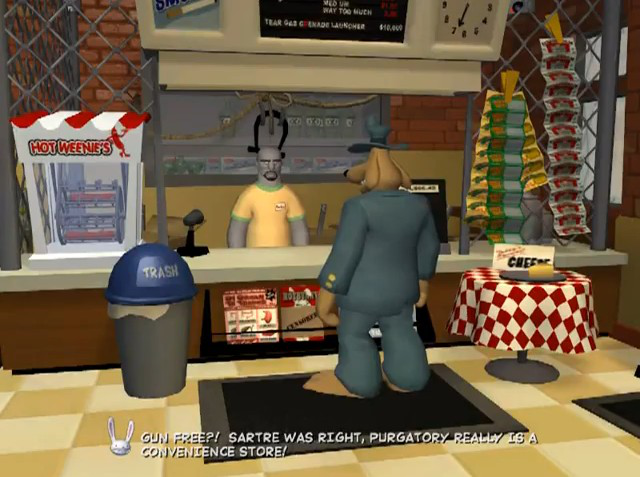
Episodic Sam & Max Telltale games have already spawned three seasons, each succeeding better than the previous one.
Gamers and critics gladly embraced the new games, and the genre seems to have come back to life - the most popular and favorite adventure games of the 90s received remakes or ports for Nintendo DS, PC, home consoles and iPhone. Console-oriented adventure games Indigo Prophecy and Heavy Rain won a wide audience, while the adventure game for Nintendo Wii Zack & Wiki: Quest for Barbaros' Treasure was warmly received by critics. Thanks to the spread of digital distribution, smaller studios became more successful, and Telltale became stronger and stronger, creating Wallace and Gromit and Strong Bad game spin-offs, as well as reviving the Monkey Island series under the leadership of Dave Grossman.
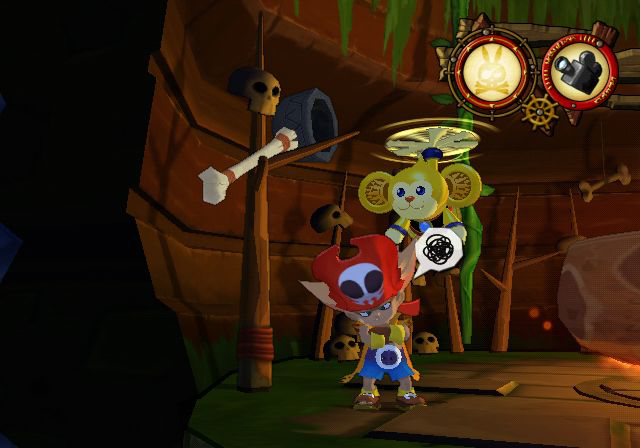
Zack & Wiki has proven that the Nintendo Wii can be a great platform for graphic adventure, but its sales have been low.
Today on the horizon are seen new games from Telltale [app. Trans .: article written in 2011] and from the creator of Whispered World Daedalic Entertainment, as well as the third part of Syberia , the new game of writer / designer Gabriel Knight Jane Jensen and remastering Broken Sword II . Whether the genre will be able to regain its former glory is a matter of time, but now it's a good time for fans of graphic adventure games.
Epilogue
During its sometimes turbulent thirty-year history, the genre of graphic adventure could become the engine of technological progress, experienced ups and downs in the waves of graphics and sound, affected the lives of millions of people and caused upsets and sometimes downsides of several well-known people and companies in the gaming industry. This genre was often stagnant due to its isolation, suffered from unwillingness to adapt to changing market conditions and the further development of interactivity. Of course, all this was characteristic of adventure games, but it seems that the peak of their innovations came in the mid-90s, followed by a lightning-fast fall (with rare exceptions). Favor for adventure developers in recent years can be attributed to their attempts at innovation - Telltale with its episode structure, Quantic Dream with a new control system (good or bad), Japanese developers, for example, Cing with games for Nintendo DS, added elements to the genre visual novels.
The heyday of casual games also did not contribute to the genre, but games about the search for hidden objects (there were a lot of them ) were often promoted as a kind of graphic adventure, which led to the emergence of more serious representatives of the genre and more attention of the audience.
Even if adventure games never return to the top of computer games, their pioneers can be sure that the genre has long been a bastion for serious video game plots and undoubtedly influenced the development of the industry as a whole. In addition to purely technological innovations, adventure promoted improvements in interface design, sound, plots, dialogs and graphics. Some mechanics and concepts, such as the time rewinding mechanics used in the famous Braid and Prince of Persia: The Sands of Time , or embedded videos used in all types of games, first appeared in adventure games. In addition, representatives of the genre remain the best demonstration of how comedy and humor can work in the form of a computer game.
All Articles